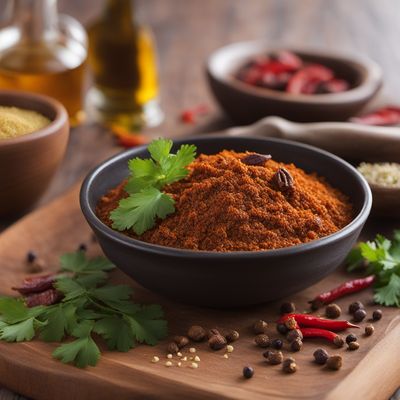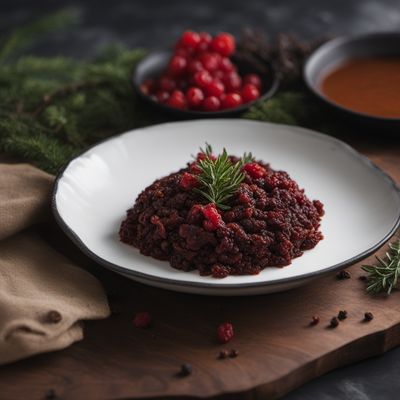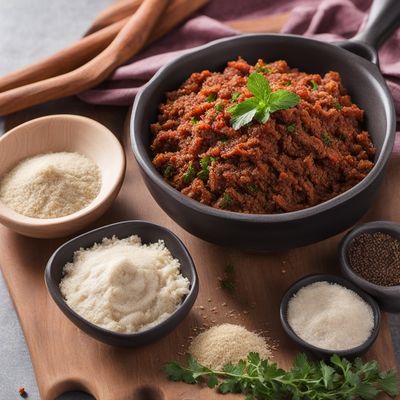
Ingredient
Bovine meat, dried
The Savory Delight: Exploring the World of Dried Bovine Meat
Dried bovine meat is made by marinating thin slices of beef in a flavorful mixture of spices, salt, and sometimes sugar, before drying it to remove moisture. The result is a chewy and savory treat that is packed with protein and intense flavor. The texture of dried bovine meat can vary from tender to tough, depending on the cut of meat and the drying process used. Its appearance is characterized by a dark, reddish-brown color and a slightly wrinkled surface.
Origins and history
The practice of drying meat for preservation dates back thousands of years, with evidence of dried meat being consumed by ancient civilizations such as the Egyptians and the Chinese. In many cultures, drying meat was a way to ensure a stable food supply during times of scarcity or for long journeys. Bovine meat, specifically beef, has been a popular choice for drying due to its rich flavor and high protein content.
Nutritional information
Dried bovine meat is a nutrient-dense ingredient, rich in protein, iron, and zinc. It is also relatively low in fat and carbohydrates. A 1-ounce (28g) serving of dried bovine meat provides approximately 116 calories, 9 grams of protein, and 7 grams of fat.
Allergens
Dried bovine meat may contain allergens such as soy, wheat, or other ingredients used in the marinade or seasoning. It is important to check the label for potential allergens before consuming.
How to select
When selecting dried bovine meat, look for slices that are evenly dried and have a firm texture. Avoid any pieces that appear overly dry, brittle, or have an off-putting odor. Opt for brands that use high-quality cuts of beef and minimal additives or preservatives.
Storage recommendations
To maintain the freshness and quality of dried bovine meat, store it in an airtight container or resealable bag in a cool, dry place. Avoid exposure to moisture, heat, or direct sunlight, as these can cause the meat to spoil or lose its texture.
How to produce
Producing dried bovine meat at home requires thinly slicing lean cuts of beef, marinating them in a mixture of spices and seasonings, and then drying them using a dehydrator or an oven set to a low temperature. It is important to follow proper food safety guidelines and ensure the meat is fully dried to prevent bacterial growth.
Preparation tips
Dried bovine meat can be enjoyed as a standalone snack or incorporated into various dishes. It can be used to add a flavorful punch to salads, stir-fries, sandwiches, or even as a topping for pizzas. To enhance its tenderness, you can briefly microwave or steam the dried bovine meat before using it in recipes.
Culinary uses
Dried bovine meat is commonly used as a portable and protein-packed snack, especially during outdoor activities or as a quick energy boost. It is also a popular ingredient in trail mixes, stews, and chili recipes, where its intense flavor adds depth to the dish.
Availability
Dried bovine meat is widely available in grocery stores, supermarkets, and specialty food stores worldwide. It is also commonly found in regions where beef is a staple meat.
More ingredients from this category
Recipes using Bovine meat, dried

Machacado Ranchero with Scrambled Eggs
Savory Mexican Breakfast Delight: Machacado Ranchero Scramble

Carne de Sol with Saharan Spices
Saharan Spiced Sun-Dried Beef

Traditional Pemmican Recipe
Savory Bison Energy Bars: A Modern Twist on Native American Pemmican

Pepita con Tasajo with Roasted Tomatillo Salsa
Savory Pumpkin Seed and Beef Stir-Fry with Tangy Tomatillo Sauce

Bosnian-Style Pasta Carbonara
Sarajevo Delight: Bosnian-Style Pasta Carbonara

Carne de Sol with Farofa: A Brazilian Delight
Savory Sun-Dried Beef with Crunchy Cassava Flour: A Taste of Brazil

